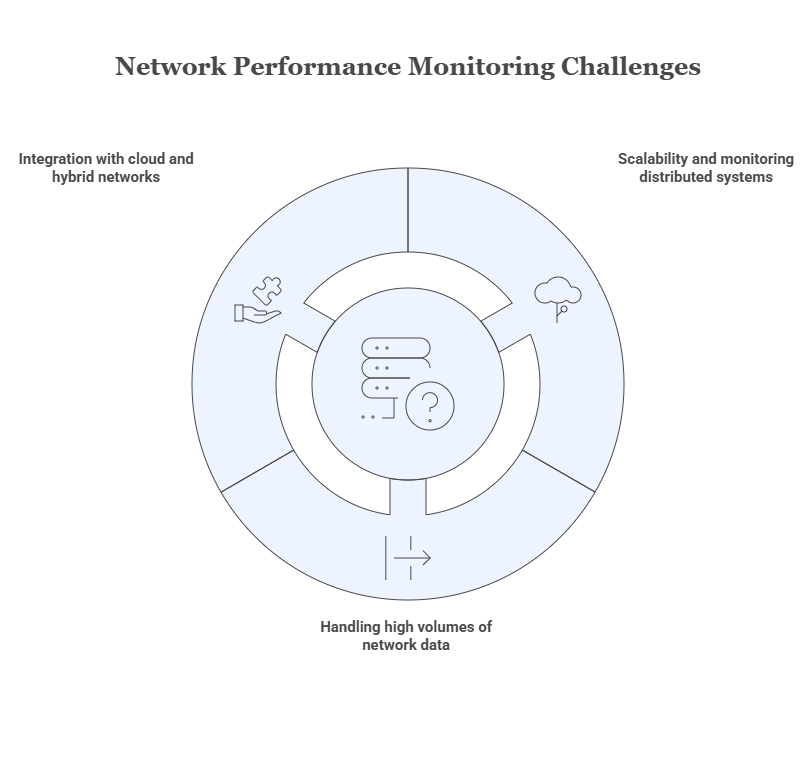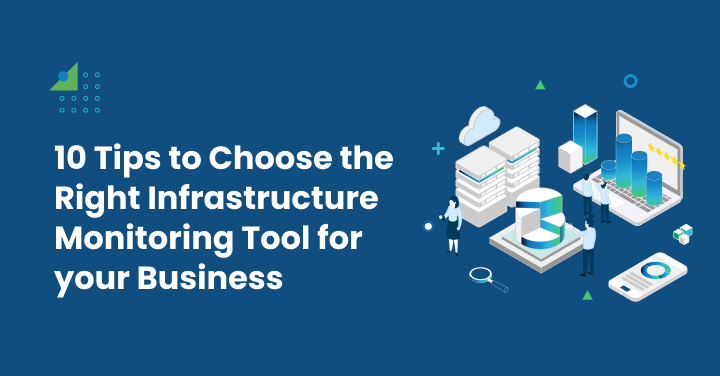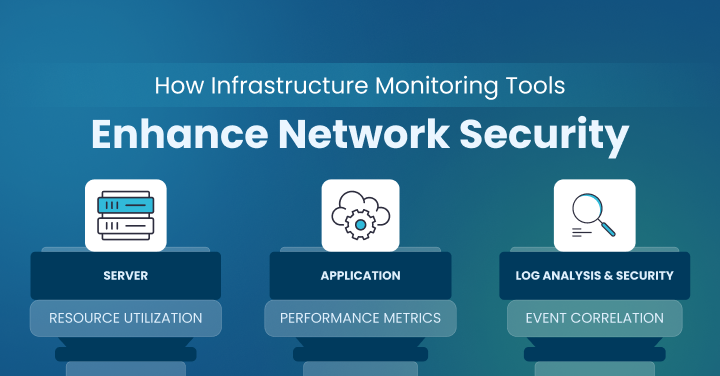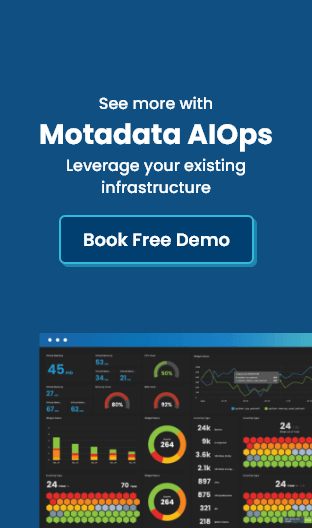The new-age businesses are doomed if the IT system doesn’t run smoothly. This is why infrastructure monitoring is key.
A good monitoring tool helps organizations see the full view of their entire infrastructure. It allows them to keep application performance at its best and reduce problems. By finding and solving potential issues early, businesses can ensure their IT operations are reliable and efficient.
Understanding Infrastructure Monitoring
Infrastructure monitoring is about constantly watching and managing an organization’s IT infrastructure. This helps keep everything running well and stable.
It includes tracking, analyzing, and controlling different infrastructure components. A good monitoring solution gathers and checks system data from servers, networks, databases, and other important parts.
By closely examining this system data, organizations can see how healthy and available their IT infrastructure is. This data-driven approach helps IT teams spot problems, fix issues, and make smart choices to improve infrastructure performance. It also ensures that applications and services are delivered reliably.
Evolution of Infrastructure Monitoring: From Basics to AI Integration
Early infrastructure monitoring mainly focused on physical servers and network devices in data centers. As technology improved, monitoring tools also evolved. They now cover virtual environments, cloud infrastructure, and complex application designs.
The newest monitoring tools use advanced technology like AI and machine learning. These tools offer better insights and help organizations act before problems arise.
They enable a shift from fundamental alerts to predictive analysis, spotting unusual patterns, and fixing issues automatically.
Key Components of Modern Infrastructure Monitoring Systems
Modern infrastructure monitoring systems are known for providing real-time visibility and alerts. They give helpful insights, too. At the heart of these systems are customizable dashboards.
These dashboards show a clear view of important infrastructure performance indicators. IT teams can adjust them to track the metrics that matter most. This helps them quickly check the health of critical components.
Advanced monitoring systems easily integrate with other IT tools and services, making it easier to handle incidents, collaborate, and automate fixes.
Such integration helps organizations run their IT operations smoothly and keeps their infrastructure working well.
Key Technologies for Infrastructure Monitoring
Modern infrastructure monitoring depends on essential technologies to keep things running well and reliably. IT teams use application performance monitoring tools to collect real-time data on systems’ performance.
Customizable dashboards provide a complete view of infrastructure parts, such as virtual machines and cloud services. Agentless monitoring solutions allow easy data collection without slowing down system performance.
With machine learning features, organizations can find potential issues early. This helps in root cause analysis to solve problems quickly.
Traditional vs. modern monitoring tools
Traditional monitoring tools often can’t keep up with the fast changes in today’s infrastructure. This can lead to missing important data and taking longer to respond.
Modern monitoring systems have been developed to fix these issues. They offer better features made for the complex IT setups we see now.
Here are the main differences between traditional and modern monitoring tools:
- Scope and Scalability: Traditional tools usually only monitor on-premises systems. In contrast, modern tools excel at tracking cloud, hybrid, and container environments.
- Automation and AI: Modern tools use automation, AI, and ML to speed up tasks. They also give early insights and help manage issues before they happen.
- Data Visualization and Dashboards: Modern systems focus on easy-to-read data visuals and customizable dashboards. This helps users understand complicated data and act on it quickly.
SNMP, NetFlow, and packet analysis
Network monitoring is essential for managing infrastructure, and some key technologies help. SNMP (Simple Network Management Protocol) is a standard tool for gathering and organizing information from network devices.
It lets administrators monitor network traffic, check device status, and track performance metrics.
NetFlow is another protocol created by Cisco that analyzes network traffic. It gives clear insights into network interactions and bandwidth usage.
By looking at NetFlow data, IT teams can identify which applications use a lot of bandwidth, detect unusual network activity, and improve network performance.
Role of AI and automation in network monitoring
AI integration and automation are improving network monitoring and IT operations. With AI and machine learning, companies can shift from reacting to problems to solving them before they happen. This way, they can fix potential issues before they affect system performance.
AI monitoring tools can quickly find what normal behavior looks like for systems. They also spot unusual activity in real time and can predict if there could be outages or drops in performance.
Automation helps with incident responses. It can fix known issues automatically. This lets IT teams avoid manual tasks and focus on more critical projects.
Best Practices for Ensuring Connectivity and Reliability
Monitoring infrastructure actively is important to ensure steady connections and constant reliability. Using best practices is key.
This includes setting up clear performance standards, configuring useful alerts, and performing regular health checks on systems.
These steps create a solid foundation for a strong monitoring plan.
Additionally, root cause analysis helps to find and fix main issues, preventing the same problems from happening again.
Organizations can strengthen their IT infrastructure by taking a complete approach that combines active monitoring, good incident management, and continuous improvement. This decreases interruptions and guarantees a better user experience.
Implementing proactive monitoring and alerting
Proactive monitoring and alerting are essential for a strong monitoring strategy. When organizations move from reactive to proactive, they can find and fix potential issues before they become big problems.
This means creating a complete set of performance metrics and setting clear thresholds for alerts. It is also necessary to set up alert systems to notify the right people quickly.
Good alerting systems provide simple, clear notifications that are easy to understand. They should also provide detailed information about the problem, helping IT teams see how serious the issue is. Setting up a process to escalate alerts ensures that urgent issues get attention, even after business hours.
Automating fault detection and resolution
Automation has a significant impact on how we manage infrastructure today. It helps organizations work better and faster. One crucial part of this change is automating how we find and fix problems. This allows businesses to reduce downtime and use their resources more effectively.
By using AI and ML, IT teams can automatically spot and solve common infrastructure issues.
Automated fault detection systems look at system data constantly. They can find unusual activity and initiate set actions, like restarting a service or adding more resources.
Network traffic optimization strategies
Optimizing network traffic is crucial for good application performance, efficient resource use, and a smooth user experience. Organizations should use several techniques to optimize network traffic. These techniques help reduce delays and congestion and focus on essential applications.
One way to do this is by setting Quality of Service (QoS) rules. QoS lets organizations prioritize specific types of network traffic, like voice calls or video meetings, ensuring high-quality performance for these critical applications. Using caching for data that people access often at key points in the network can help reduce delays and save bandwidth.
Benefits of Effective Infrastructure Monitoring
Good infrastructure monitoring has many important benefits. When organizations have a strong monitoring plan, they can see more uptime, better application performance, and greater security.
Proactive monitoring helps IT teams find and fix potential issues before they become bigger problems. This reduces downtime and ensures that users have a smooth experience.
Additionally, effective monitoring saves money by improving resource utilization, improving IT operations, and stopping expensive service interruptions.
By spotting and fixing performance bottlenecks, organizations can use their resources wisely and avoid extra costs. A solid monitoring strategy brings many benefits.
1. Minimizing Downtime with Predictive Analytics
Predictive analytics is changing how we monitor infrastructure. It helps organizations see potential issues before they happen. By using past data, statistical methods, and machine learning, predictive analytics can find patterns and predict possible downtime or performance issues.
This approach helps IT teams take action early. For example, if predictive analytics shows that a server is almost entirely full, IT can add more resources or move applications to avoid problems.
2. Cost Reduction Strategies Through Efficient Monitoring
Efficient monitoring is vital. It helps keep systems running well and saves money. Organizations with a clear monitoring plan can use resources better, improve IT work, and avoid expensive outages.
Monitoring performance in real-time helps IT teams spot and fix issues quickly. For example, if a server is not used much, resources can be shifted around to use them better. If a server is often overloaded, it might mean more resources are needed or applications should be optimized.
Challenges in Network Performance Monitoring
While monitoring system performance offers excellent benefits, there can be challenges when setting up and managing this system. One big challenge is making sure it can grow. As networks get more prominent and data increases, the monitoring solution must keep up without losing performance or accuracy.
Another challenge is dealing with large data volumes. Today’s networks produce a lot of data, and it can be tough to store, process, and analyze this information. Adding monitoring tools to existing IT ecosystems can also create integration challenges. These may include issues with compatibility or complicated setups.
1. Scalability and monitoring distributed systems
As organizations use more distributed systems, cloud environments, and microservices, scaling is significant for network performance monitoring. Older monitoring methods, which are meant for centralized systems, have difficulty keeping up with today’s changing and widespread infrastructures.
Monitoring solutions must expand quickly, adding more monitoring power as the systems expand. This means we need tools to gather and analyze data from many sources without slowing things down. Cloud-based monitoring solutions are often a good choice because they can grow with the system.
2. Handling high volumes of network data
The large amount of data created by modern applications and networks makes it hard to monitor network performance. To get valuable insights from this massive data, we need good ways to store, process, and analyze it.
Log management solutions are essential for handling a lot of network data. They offer a central place to gather, organize, and search through logs. IT teams easily store, manage, and check substantial log files. By using data retention policies, we can save on storage costs by automatically getting rid of old or unneeded data.
3. Integration with cloud and hybrid networks
As companies use cloud technologies, connecting infrastructure monitoring with cloud and hybrid environments is critical. However, cloud integration has its challenges because cloud resources are constantly changing, and many cloud providers exist.
Monitoring tools must quickly work with cloud platforms like AWS, Azure, and Google Cloud. They should collect data and logs from different cloud services and resources. This connection helps organizations clearly see their hybrid setup, which includes both local and cloud parts.
Conclusion
Effective infrastructure monitoring is key to ensuring your network stays connected and reliable. Modern monitoring systems use AI, predictive analytics, and automation to help businesses find and fix problems early.
This can improve network traffic and reduce downtime. It’s essential to use best practices, like having proactive alerts and monitoring for systems spread out across locations.
Even though there can be challenges with scaling and handling large amounts of data, efficient infrastructure monitoring brings benefits like lower costs and better security.
Infrastructure monitoring is a must for today’s networks. Stay ahead of problems and boost network performance with intelligent monitoring solutions that fit your business needs.
FAQs:
Infrastructure monitoring is vital for today’s networks. It helps businesses keep their systems running well, making their operations more efficient. It also allows them to manage resources better. Finally, it ensures that their IT infrastructure is reliable and stable.
Infrastructure monitoring helps improve network security and allows for the early detection of security risks. When businesses look at system logs and monitoring data, they can take quick action against potential threats. This keeps sensitive data safe and ensures a secure IT environment.
Infrastructure monitoring is important for all types of businesses, not just the big ones. Affordable and scalable options are available that help small businesses improve their operational efficiency. These solutions allow them to find potential issues early and keep their critical IT systems running smoothly.
To start infrastructure monitoring, the first step is to complete the system check. This helps you find essential parts and set your monitoring goals. You also need to create a clear plan that explains the main metrics, the limits for each metric, and how to send alerts.
Picking the best tools for monitoring your infrastructure means considering your business needs. Consider how big your infrastructure is and how much you want to customize it. Consider things like how easy the tools are to use, their prices, how well they integrate with other systems, and the support provided by the vendor. All these factors will help you make a smart choice.








